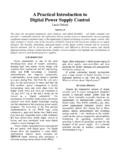Transcription of Analog and Digital MEMS Microphone Design …
1 Technical Article MS-2472.. Analog and Digital MEMS. Microphone Design OUTPUT. Considerations AMPLIFIER OUTPUT. by Jerad Lewis MEMS. TRANSDUCER. POWER. Microphones are transducers that convert acoustic pressure waves to electrical signals. Sensors have become more VDD GND. integrated with other components in the audio signal chain, Figure 1. Typical Analog MEMS Microphone Block Diagram and MEMS technology is enabling microphones to be smaller and available with either Analog or Digital outputs. Analog and Digital Microphone output signals obviously CLK. have different factors to be considered in a Design .
2 I will AMPLIFIER ADC. PDM. MODULATOR DATA. examine the differences and Design considerations when MEMS. integrating Analog and Digital MEMS microphones into a TRANSDUCER. POWER CHANNEL. system Design . MANAGEMENT SELECT. Inside a MEMS Microphone The output of a MEMS Microphone does not come directly L/R SELECT. GND. VDD. from the MEMS transducer element. The transducer is essentially a variable capacitor with an extremely high output impedance in the gigaohm range. Inside the Figure 2. Typical PDM MEMS Microphone Block Diagram Microphone package, the transducer's signal is sent to a preamplifier, whose first function is an impedance converter to bring the output impedance down to something more MEMS.
3 TRANSDUCER. usable when the Microphone is connected in an audio signal FILTER. chain. The Microphone 's output circuitry is also ADC Serial Data Clock I2S. implemented in this preamp. For an Analog MEMS SERIAL Serial Data Output Microphone , this circuit, whose block diagram is shown in POWER HARDWARE. PORT Word Clock Figure 1, is basically an amplifier with a specific output MANAGEMENT CONTROL. impedance. In a Digital MEMS Microphone , that amplifier is integrated with an Analog -to- Digital converter (ADC) to GND. VDD. provide a Digital output in either a pulse density modulated (PDM) or I2S format.
4 Figure 2 shows a block diagram of a Figure 3. Typical I2S MEMS Microphone Block Diagram PDM-output MEMS Microphone and Figure 3 shows a A lid is then bonded over the laminate to enclose the typical I2S-output Digital Microphone . The I2S Microphone transducer and ASIC. This laminate is basically a small PCB. contains all of the Digital circuitry that a PDM Microphone that is used to route the signals from the ICs to the pins on has, as well as a decimation filter and serial port. the outside of the Microphone package. Figures 4 and 5 show A MEMS Microphone package is unique among the inside of Analog and Digital MEMS microphones, semiconductor devices, in that there is a hole in the package respectively.
5 In these pictures you can see the transducer on for the acoustic energy to reach the transducer element. the left and ASIC (under the epoxy) on the right side, both Inside this package, the MEMS Microphone transducer and mounted on the laminate. The Digital Microphone has the Analog or Digital ASIC are bonded together and mounted additional bond wires to connect the electrical signals from on a common laminate. the ASIC to the laminate. Page 1 of 4 2013 Analog Devices, Inc. All rights reserved. MS-2472 Technical Article The output of an Analog MEMS mic is usually biased at a dc voltage somewhere between ground and the supply voltage.
6 This bias voltage is chosen so that the peaks of the highest amplitude output signals won't be clipped by either the supply or ground voltage limits. The presence of this dc bias also means that the Microphone will usually be ac-coupled to the following amplifier or converter ICs. The series capacitor needs to be selected so that the high-pass filter circuit that is formed with the codec or amplifier's input impedance doesn't roll off the signal's low frequencies above the Microphone 's natural low frequency roll-off. For a Microphone with a 100 Hz low frequency 3 dB point and a codec or amplifier with a 10 k input impedance (both Figure 4.)
7 Transducer and ASIC of an Analog MEMS Microphone common values), even a relatively small F capacitor puts the high-pass filter corner at 16 Hz, well out of the range where it will affect the Microphone 's response. Figure 6. shows an example of this sort of circuit, with an Analog MEMS Microphone connected to an op amp in a noninverting configuration. Digital Microphones Digital microphones move the Analog -to- Digital conversion function from the codec into the Microphone , enabling an all Digital audio capture path from the Microphone to the processor. Digital MEMS microphones are often used in applications where Analog audio signals may be susceptible to interference.
8 For example, in a tablet computer, the Figure 5. Transducer and ASIC of a Digital MEMS Microphone Microphone placement may not be near to the ADC, so the signals between these two points may be run across or near Analog Microphones Wi-Fi, Bluetooth, or cellular antennae. By making these An Analog MEMS Microphone 's output impedance is connections Digital , they are less prone to picking up this RF. typically a few hundred ohms. This is higher than the low interference and producing noise or distortion in the audio output impedance that an op amp typically has, so you need signals.
9 This improvement in pickup of unwanted system to be aware of the impedance of the stage of the signal chain noise provides greater flexibility in Microphone placement in immediately following the Microphone . A low impedance the Design . stage following the Microphone will attenuate the signal level. For example, some codecs have a programmable gain Digital microphones are also useful in systems that would amplifier (PGA) before the ADC. At high gain settings, the otherwise only need an Analog audio interface to connect to PGA's input impedance may be only a couple of kilohms.
10 A an Analog Microphone . In a system that only needs audio PGA with a 2 k input impedance following a MEMS capture and not playback, like a surveillance camera, a Microphone with a 200 output impedance will attenuate Digital output Microphone eliminates the need for a separate the signal level by almost 10%. codec or audio converter and the Microphone can be V. connected directly to a Digital processor. VREF. R1 R2. Of course, good Digital Design practices must still be applied F to a Digital Microphone 's clock and data signals. Small value (20 to 100 ) source termination resistors are often useful VDD.


















